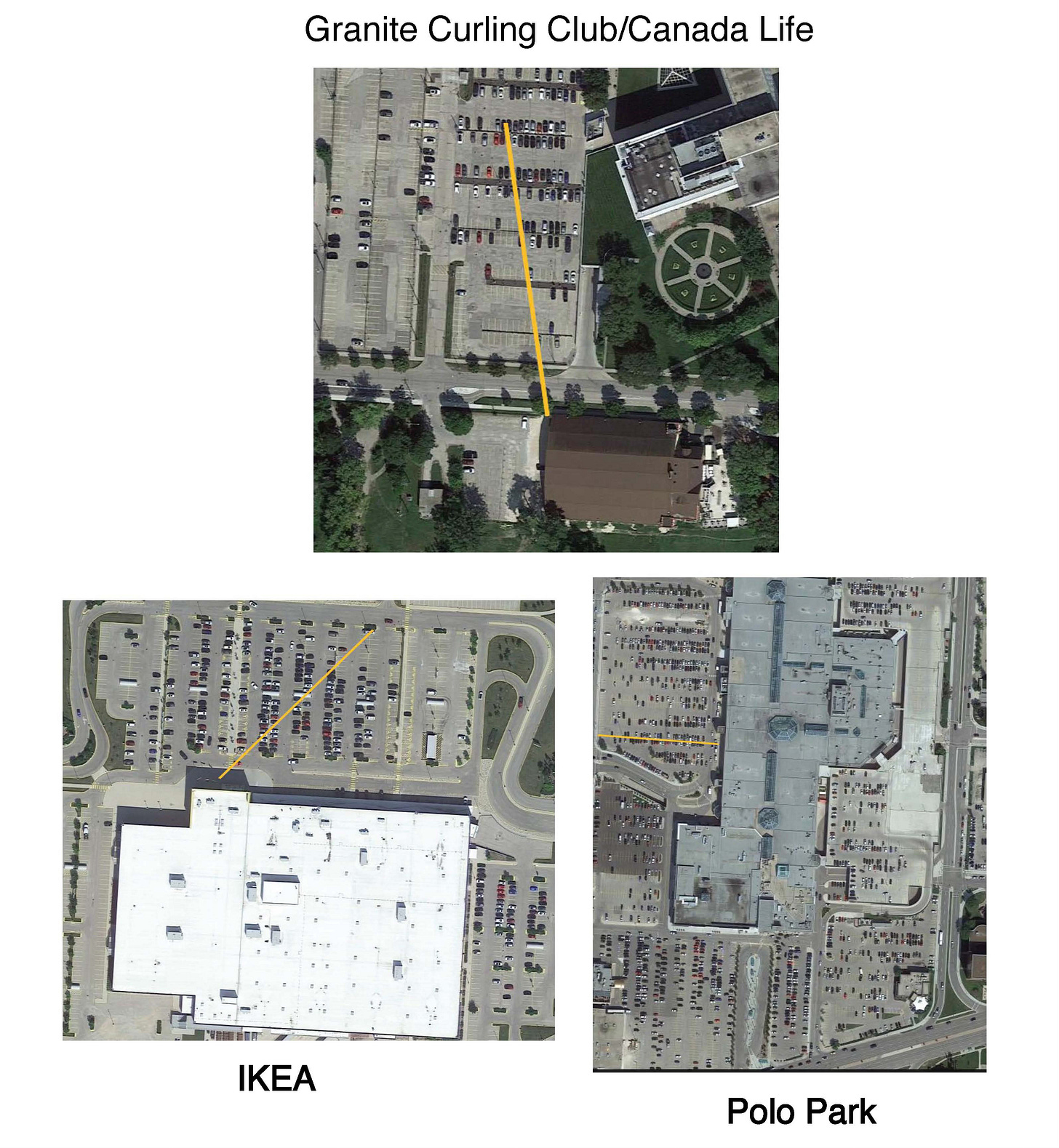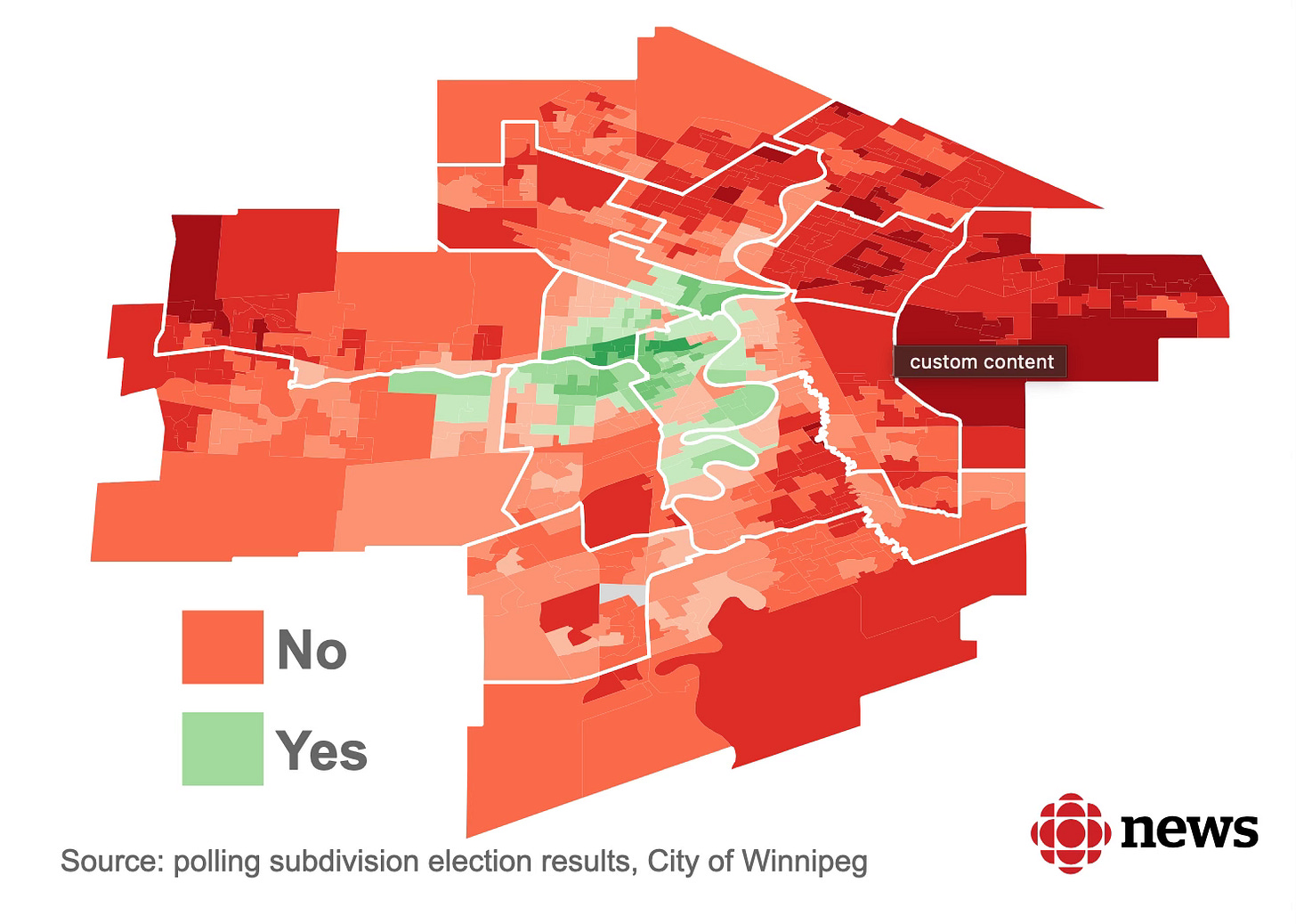The Sad Predictable Day
Everything about the Granite Curling Club public hearing was predictable
On February 6th, Winnipeg Council SPC on Planning and Development held a public hearing for a subdivision and zoning change at the Granite Curling Club. There was a lot of buzz heading into the public hearing with the club executive being opposed to the application. The proposal is to subdivide out the parking lot at the back of the club and rezone that to allow a mixed-use, mixed-income residential building.
In the end, after 10 hours of public hearing and over 40 people presenting their opinions with the committee, both in support and opposed, Councillors on the committee did not make a decision. The vote on the proposal was 2/2, which means that while technically it lost on a tie, it will go forward to full Council without a recommendation, with a stop at the Executive Policy Committee on the way.
Predictable Day
In anticipation of the public hearing, I shared some thoughts on this application and the public discourse that was happening ahead of it. I tried to show why this project should be approved, why it is good not only for the neighbourhood of West Broadway but also for the entire city. It is clearly exactly the kind of development and growth that we need and have agreed to work towards.
Sadly, and predictably, my relatively cynical take that there would be more concern about parking than housing was born out.
Parking over People, again
The Granite Curling Club has joined the annals of NIMBYism by decrying a housing project next to them because it will take away some of the parking they use. They are fighting a proposal for a housing project on city land adjacent to the club because they are losing 60 parking spots. The proposal by the City of Winnipeg is to build a building on an adja…
Same Old, Same Old
I’ve sat through countless public presentations on various issues over many years. In my 10 years on Calgary City Council we spent a lot of time listening to the public about secondary suites, affordable housing developments, and municipal plans. What I saw and heard yesterday was not much different than what I experienced in Calgary.
I’ve noticed consistent patterns in the opposition, not just in Winnipeg or in Calgary, but in cities right across Canada. These patterns present barriers to making change and growing as a community. They prevent us from making the decisions we need to make in order to become a more inclusive and sustainable city. And they present the biggest challenge we need to overcome if we are to seriously address the challenges we face as a community such as financial viability, climate change, the housing crisis, and poverty.
Parking
It seems to always come down to parking. No matter the issue, parking is always the trump card. Whether for affordable housing, or a bike lane, or a corner store, parking always seems to be the prime concern. “Where am I going to park?” is the plaintiff cry of so many people. And yet, we live in a world with more parking than we know what to do with. Our local malls have so much parking they get to use it for big snow piles and fenced off gardening supplies.
For the Granite Curling Club, the proposal is to have the parking lot behind the building, where the housing is going to be, reduced from 60 stalls to 15 being reserved for curlers. A loss of 45 parking spots for the curlers (which according to the executive of the club will kill the club. That, of course, begs the question of their fiscal management capabilities.)
As was pointed out, there are hundreds of parking spots on the street and in the massive parking lot directly across the street. Hundreds of parking spots in the immediate area. But across the street is further away than right next to the building, which is further away and too inconvenient for curlers to walk that extra 100 feet to get to the front door. (see overhead shots in my previous post)
Parking, we hear, always needs to be adjacent otherwise businesses will die and curlers won’t come. Across the street or around the corner is too far. But, when we go to Ikea, or Polo Park, for some reason it isn’t too far. The parking for our shopping malls is further away from the front door than any of the available parking at the curling across the street for the curling club.
Below is a comparison of the 3 parking situations. In each image is a bar that is 120m long to indicate how far away parking is.
Local Support
I live in West Broadway, a few blocks from the Granite Curling Club. During the public hearing the breakdown of where presenters lived was quite stark. Those closest to the Club, residents of West Broadway and Downtown, spoke eloquently in favour of more housing for their neighbourhood. They highlighted the need for housing, and in particular affordable housing. The proposed project will help address that need, with more than half the units that will have affordable or deeply affordable rents.
People who live in the area also pointed out that there is ample parking next to the curling club, indeed right across the downtown. The clear opportunity for adding housing in our downtown is on the vast number of parking lots. In fact, about 20% of the downtown area is dedicated to surface parking lots.
The local voice, both of neighbours and of club members, was starkly contrasted by those club members who don’t live in the area, and drive in from across the city to curl in our wonderful inner city curling club. Those members, who don’t live in the area, who come in for an hour or two at a time, dominated the discussion.
The map of the vote results for the opening of Portage and Main could very easily reflect the voices that council heard. A result that replays over and over on issue after issue: densification, transit, bike lanes, housing, pools; the divide on so many issues could be mapped by the vote result of the Portage and Main plebiscite.
Age Gap
Another factor that was obvious in the presenters was the age difference of those in favour vs those opposed. Generally, those who spoke in favour, talking about the need for more housing and the opportunity for the neighbourhood were younger than those who were opposed to the changes. There was considerably more grey hair in the opposition group.
The pattern seems to be that younger community members are more wiling and interested in discussing the future and what needs to be done to improve community. This pattern repeats itself across many issues such as transit planning, climate change, as well as urban planning.
One More Thing
One other challenge is the ongoing issue of public participation with City Council. Concerned citizens spent an entire day at City Hall to have their voices heard. When it comes to zoning, a Public Hearing is the primary means of addressing council and going on record with your opinion. It is no small investment for a member of the public, no matter their age, to spend 10 hours sitting in Council Chambers for their 5 minutes to speak to council.
And for all their passion about the issue, their commitment to making their voice heard by City Council, only 4 members of Council were there to listen to them. 75% of City Council will never hear the delegations of people speaking passionately about the future of their community and why we need more housing. Nor will that 75% of City Council hear from others that parking is their number one concern.
I wrote about this more fully last month:
Politics
There is no magic bullet to fix this unproductive and unhelpful dichotomy. I spent 10 years as a City Councillor trying to overcome these hurdles and bridge the gap in the divisions of parking vs people, inner city vs suburbs, and older vs younger. My success was mixed.
What became obvious yesterday in Winnipeg was the need for Councillors to follow through on commitments and show leadership. The proposal for this rezoning was before City Council because of unanimous decisions made by them. The proposal was there because of the recognition of the desperate need for more housing, a recognition that led to the City of Winnipeg applying for and receiving $122M of federal money for the Housing Accelerator Fund. That very decision is what brought this application before them.
Our municipal leaders must follow through on their commitment. While they argue for more housing, and support doing what is needed to achieve that in a thoughtful way, that commitment from our leaders must extend beyond the theoretical into the practical. Turning a parking lot for 60 cars into 110 homes is the very manifestation of their direction.
Political Courage
Just as the outcome of yesterday’s vote was sadly predictable, so too were the arguments of the opposition. The Councillors knew that. Despite the willful ignorance demonstrated by some, they are all experienced members of council and they know everything that I observed as well. The day, all aspects of the day, were all too predictable.
We need our City Council to be the leaders they were to be. To follow through on commitments for a better city, to a city for all. To follow through on their commitment to the Strategic Vision they developed, endorsed, and enshrined. Every report that comes to City Council from City of Winnipeg administration must demonstrate its alignment with the strategic plans and vision of the city.
Council decisions need to align with the strategic plans and vision as well.
That starts with putting people over cars. That starts with prioritizing where people are going to sleep not where cars are going to sleep.
- brian









